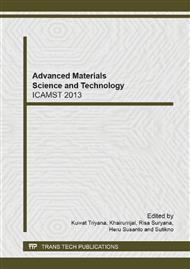[1]
S. –H. Lo, D. A. Buchanan, Y. Taur, W. Wang, Quantum-mechanical modeling of electron tunneling current from the inversion layer of ultra-thin-oxide nMOSFET's, IEEE Electron Device Lett. 18 (1997) 209-211.
DOI: 10.1109/55.568766
Google Scholar
[2]
F. A. Noor, M. Abdullah, Sukirno, Khairurrijal, A. Ohta, S. Miyazaki, Electron and hole components of tunneling currents through an interfacial oxide-high-k gate stack in metal-oxide-semiconductor capacitors, J. Appl. Phys. 108 (2010).
DOI: 10.1063/1.3503457
Google Scholar
[3]
N. A. Chowdhury, D. Misra, Charge trapping at deep states in Hf–silicate based high-k gate dielectrics, J. Electrochem. Soc. 154 (2007) G30-G37.
DOI: 10.1149/1.2402989
Google Scholar
[4]
A. Aziz, K. Kassami, ka. Kassami, F. Olivie, Modelling of the influence of charges trapped in the oxide on the I(Vg) characteristics of metal-ultra-thin oxide-semiconductor structure Semicond. Sci. Technol. 19 (2004) 877-884.
DOI: 10.1088/0268-1242/19/7/017
Google Scholar
[5]
A. Bouazra, S. A. –B. Nasrallah, A. Poncet, M. Said, Current tunnelling through MOS devices, Mater. Sci. Eng. C 28 (2008) 662-665.
DOI: 10.1016/j.msec.2007.10.010
Google Scholar
[6]
F. A. Noor, M. F. Sahdan, P. Achmari, F. Iskandar, M. Abdullah, Khairurrijal, Electron tunnel current through HfO2/SiO2 nanometer thick layers with a trapped charge: effects of electron incident angle and silicon substrate orientation, AIP Conference Proceedings 1415, American Institute of Physics, Melville, NY, 2011, pp.32-35.
DOI: 10.1063/1.3667213
Google Scholar
[7]
F. A. Noor, F. Iskandar, M. Abdullah, Khairurrijal, Analysis of electron leakage current in MOS capacitors by using anisotropic and isotropic mass approaches, Electron. Lett. 48 (2012) 1585-1586.
DOI: 10.1049/el.2012.2343
Google Scholar
[8]
F. A. Noor, M. Abdullah, Sukirno, Khairurrijal., Comparison of electron transmittances and tunneling currents in ananisotropic TiNx/HfO2/SiO2/p-Si(100) metal–oxide–semiconductor (MOS) capacitor, J. Semicond. 31 (2010) 124002-1-124002-5.
DOI: 10.1088/1674-4926/31/12/124002
Google Scholar
[9]
L. F. Mao, The effects of the injection-channel velocity on the gate leakage current of nanoscale MOSFETs, IEEE Electron Devices Lett. 28 (2007) 161-163.
DOI: 10.1109/led.2006.889214
Google Scholar
[10]
D. Ahn, S. L. Chuang, Exact calculations of quasi-bound states of an isolated quantum well with uniform electric fields: quantum-well Stark resonance, Phys. Rev. B. 34 (1986) 9034- (1937).
DOI: 10.1103/physrevb.34.9034
Google Scholar


